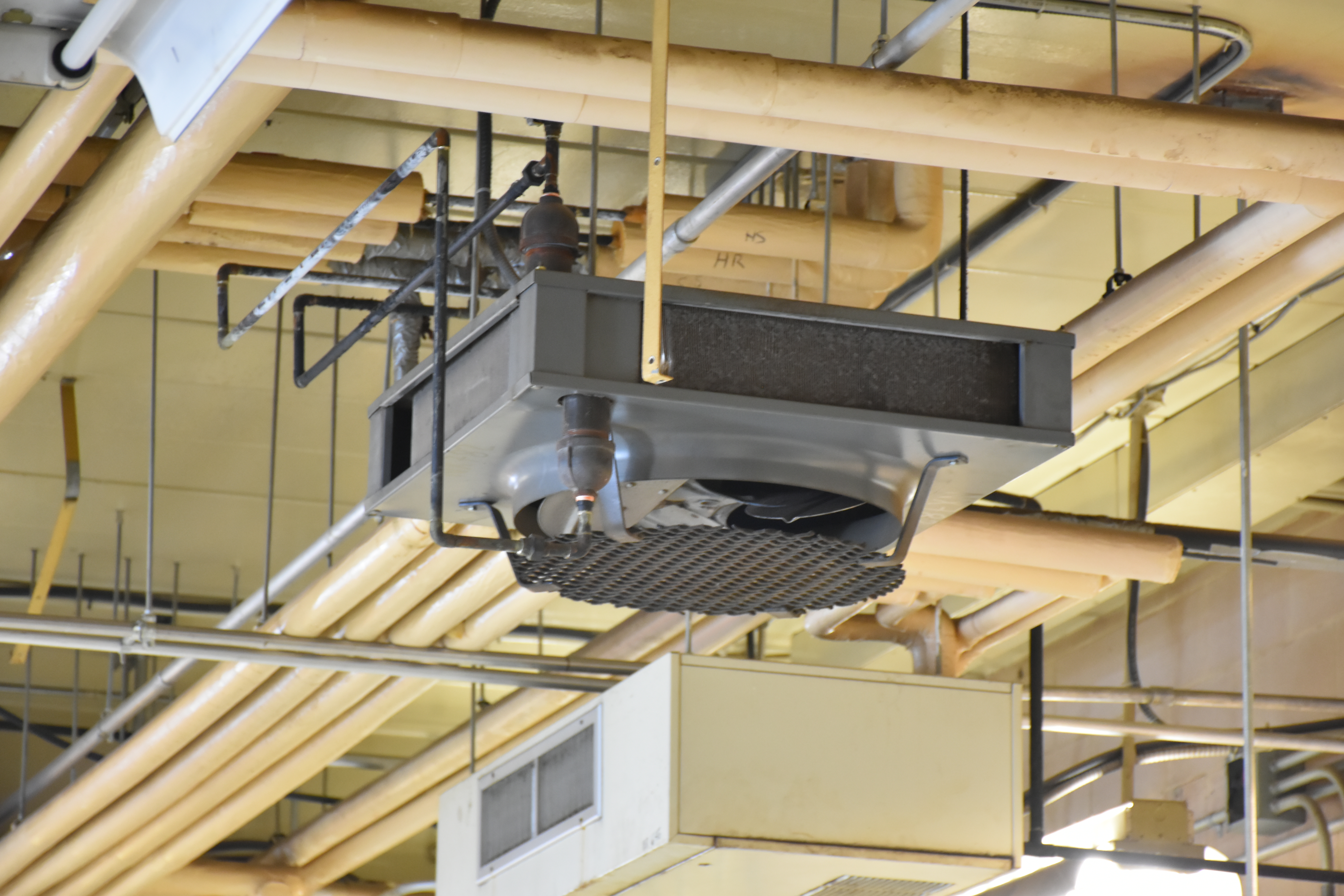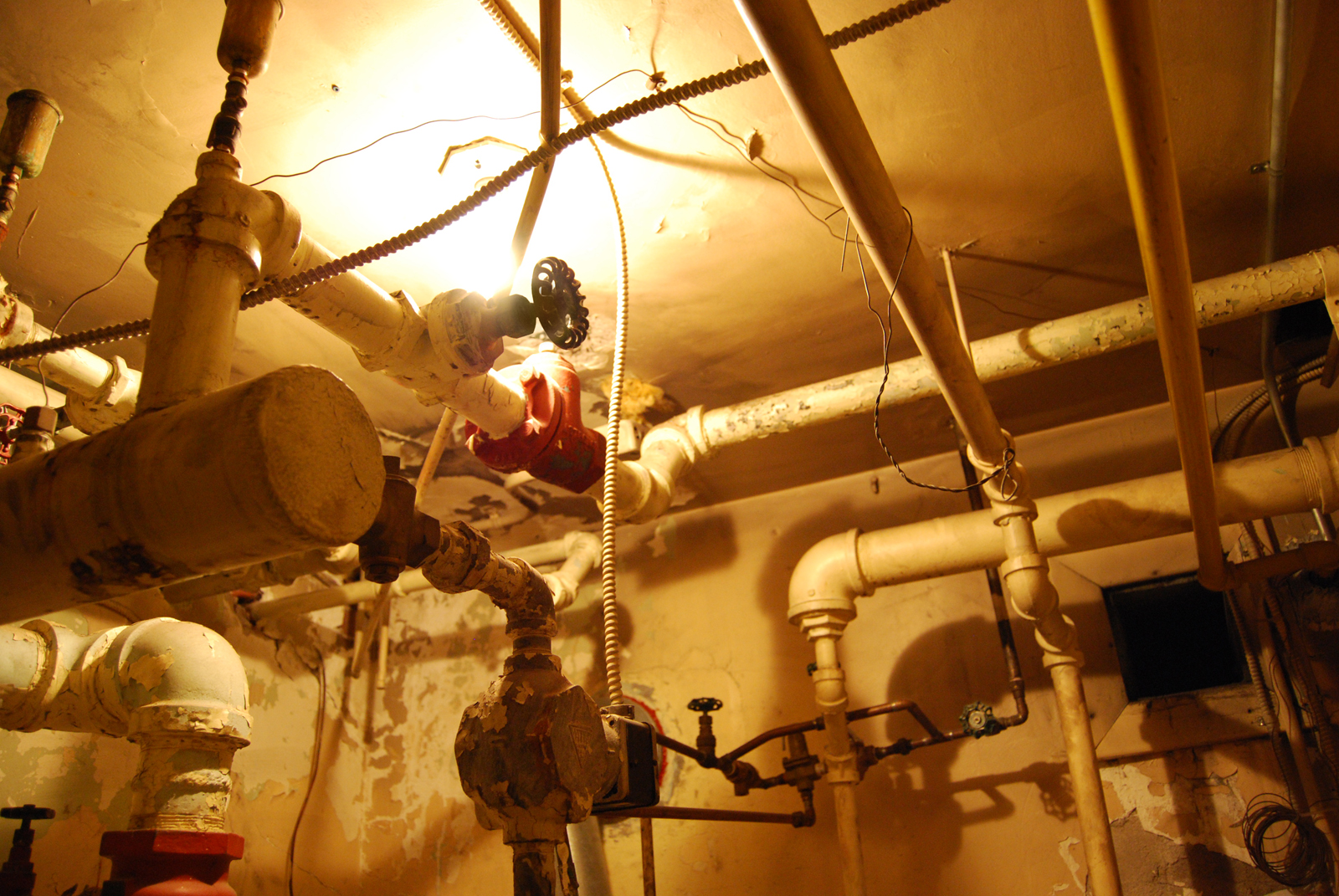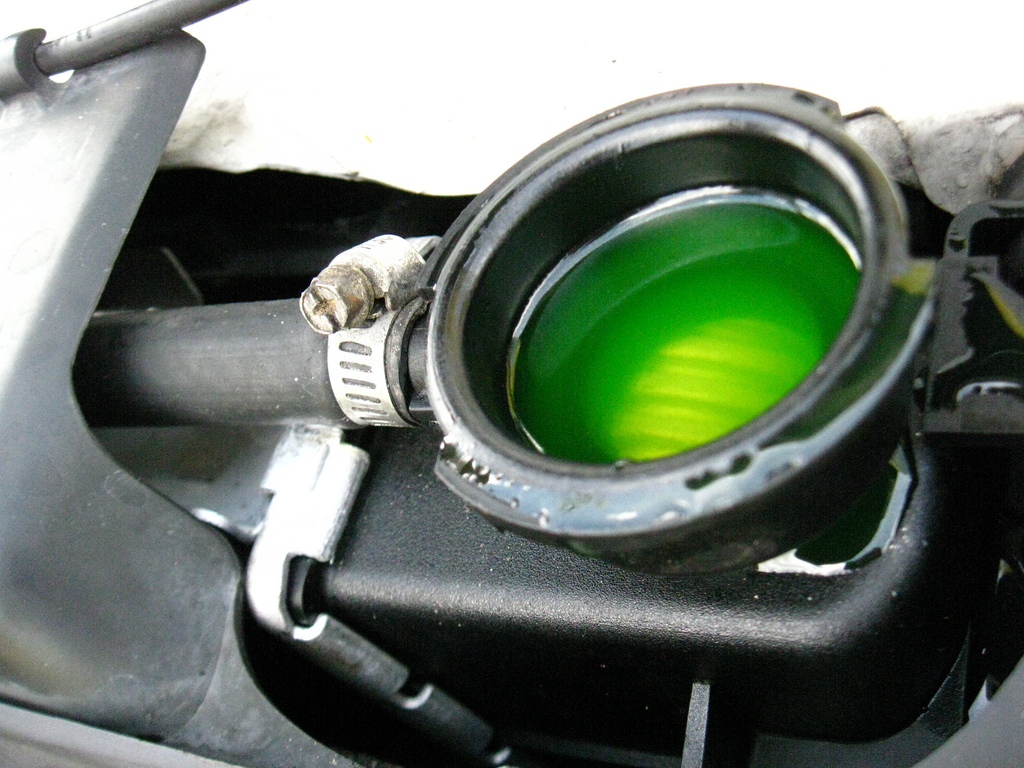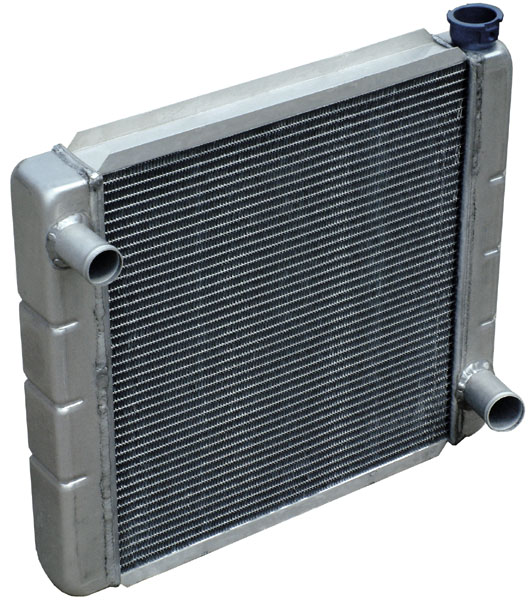|
Expansion Tank
An expansion tank or expansion vessel is a small tank used to protect closed water heating systems and domestic hot water systems from excessive pressure. The tank is partially filled with air, whose compressibility cushions shock caused by water hammer and absorbs excess water pressure caused by thermal expansion. Description The modern vessel is a small container or tank divided in two by a rubber diaphragm. One side is connected to the pipe work of the heating system and therefore contains water. The other, the dry side, contains air under pressure, and normally a Schrader valve (car-tire type valve stem) for checking pressures and adding air when needed. When the heating system is empty or at the low end of the normal range of working pressure, the diaphragm is pushed against the water inlet; as the water pressure increases, the diaphragm moves, compressing the air on its other side. An older style of expansion tank was larger, oriented horizontally, and had no rubber diaphra ... [...More Info...] [...Related Items...] OR: [Wikipedia] [Google] [Baidu] |
Hydronic
Hydronics () is the use of liquid water or gaseous water (steam) or a water solution (usually glycol with water) as a heat-transfer medium in heating and cooling systems. The name differentiates such systems from oil and refrigerant systems. Historically, in large-scale commercial buildings such as high-rise and campus facilities, a hydronic system may include both a chilled and a heated water loop, to provide for both heating and air conditioning. Chillers and cooling towers are used either separately or together as means to provide water cooling, while boilers heat water. A recent innovation is the chiller boiler system, which provides an efficient form of HVAC for homes and smaller commercial spaces. District heating Many larger cities have a district heating system that provides, through underground piping, publicly available high temperature hot water and chilled water. A building in the service district may be connected to these on payment of a service fee. Types o ... [...More Info...] [...Related Items...] OR: [Wikipedia] [Google] [Baidu] |
Plumbing
Plumbing is any system that conveys fluids for a wide range of applications. Plumbing uses piping, pipes, valves, piping and plumbing fitting, plumbing fixtures, Storage tank, tanks, and other apparatuses to convey fluids. HVAC, Heating and cooling (HVAC), Sewerage, waste removal, and Drinking water, potable water delivery are among the most common uses for plumbing, but it is not limited to these applications. The word derives from the Latin for lead, ''plumbum'', as the first effective pipes used in the Sanitation in ancient Rome, Roman era were lead pipes. In the developed world, plumbing infrastructure is critical to public health and sanitation. Boilermakers and pipefitters are not plumbers although they work with piping as part of their trade and their work can include some plumbing. History Plumbing originated during ancient civilizations, as they developed public baths and needed to provide drinking water, potable water and sewerage, wastewater removal for large ... [...More Info...] [...Related Items...] OR: [Wikipedia] [Google] [Baidu] |
Hydraulic Accumulator
A hydraulic accumulator is a pressure storage reservoir in which an Incompressible flow, incompressible hydraulic fluid is held under pressure that is applied by an external Prime mover (engine), source of mechanical energy. The external source can be an engine, a spring (device), spring, a raised weight, or a compressed gas.Although liquids are generally considered to be practically incompressible, gases may be compressed and this compressed gas is a convenient energy store. An accumulator enables a hydraulic system to cope with extremes of demand using a less powerful pump, to respond more quickly to a temporary demand, and to smooth out pulsations. It is a type of energy storage device. Compressed gas accumulators, also called hydro-pneumatic accumulators, are by far the most common type. Types of accumulator Towers The first accumulators for William Armstrong, 1st Baron Armstrong, William Armstrong's hydraulic dock machinery were simple raised water towers. Water was pumped ... [...More Info...] [...Related Items...] OR: [Wikipedia] [Google] [Baidu] |
Hydronics
Hydronics () is the use of liquid water or gaseous water (steam) or a water solution (usually glycol with water) as a Heat transfer, heat-transfer medium in heating system, heating and cooling systems. The name differentiates such systems from Oil cooling, oil and refrigerant systems. Historically, in large-scale commercial buildings such as high-rise and campus facilities, a hydronic system may include both a chilled and a heated water loop, to provide for both heating and air conditioning. Chillers and cooling towers are used either separately or together as means to provide water cooling, while boilers heat water. A recent innovation is the chiller boiler system, which provides an efficient form of HVAC for homes and smaller commercial spaces. District heating Many larger cities have a district heating system that provides, through underground piping, publicly available high temperature hot water and chilled water. A building in the service district may be connected to the ... [...More Info...] [...Related Items...] OR: [Wikipedia] [Google] [Baidu] |
Pumping Station
Pumping stations, also called pumphouses, are public utility buildings containing pumps and equipment for pumping fluids from one place to another. They are critical in a variety of infrastructure systems, such as water supply, Land reclamation, drainage of low-lying land, canals and removal of sewage to processing sites. A pumping station is an integral part of a pumped-storage hydroelectricity installation. Pumping stations are designed to move water or sewage from one location to another, overcoming gravitational challenges, and are essential for maintaining navigable canal levels, Water supply, supplying water, and managing sewage and floodwaters. In canal systems, pumping stations help replenish water lost through lock usage and leakage, ensuring navigability. Similarly, in land drainage, stations pump water to prevent flooding in areas below sea level, a concept pioneered during the Victorian era in places like The Fens in the UK. The introduction of "package pumping statio ... [...More Info...] [...Related Items...] OR: [Wikipedia] [Google] [Baidu] |
Antifreeze
An antifreeze is an additive which lowers the freezing point of a water-based liquid. An antifreeze mixture is used to achieve freezing-point depression for cold environments. Common antifreezes also increase the boiling point of the liquid, allowing higher coolant temperature. However, all common antifreeze additives also have lower heat capacity, heat capacities than water, and do reduce water's ability to act as a coolant when added to it. Because water has good properties as a coolant, water plus antifreeze is used in internal combustion engines and other heat transfer applications, such as HVAC chillers and solar water heaters. The purpose of antifreeze is to prevent a rigid enclosure from bursting due to expansion when ice, water freezes. Commercially, both the ''additive'' (pure concentrate) and the ''mixture'' (diluted solution) are called antifreeze, depending on the context. Careful selection of an antifreeze can enable a wide temperature range in which the mixture remain ... [...More Info...] [...Related Items...] OR: [Wikipedia] [Google] [Baidu] |
Internal Combustion Engine
An internal combustion engine (ICE or IC engine) is a heat engine in which the combustion of a fuel occurs with an oxidizer (usually air) in a combustion chamber that is an integral part of the working fluid flow circuit. In an internal combustion engine, the expansion of the high-temperature and high-pressure gases produced by combustion applies direct force to some component of the engine. The force is typically applied to pistons (reciprocating engine, piston engine), turbine blades (gas turbine), a Wankel engine, rotor (Wankel engine), or a propulsive nozzle, nozzle (jet engine). This force moves the component over a distance. This process transforms chemical energy into kinetic energy which is used to propel, move or power whatever the engine is attached to. The first commercially successful internal combustion engines were invented in the mid-19th century. The first modern internal combustion engine, the Otto engine, was designed in 1876 by the German engineer Nicolaus ... [...More Info...] [...Related Items...] OR: [Wikipedia] [Google] [Baidu] |
Internal Combustion Engine Cooling
Internal combustion engine cooling uses either air or liquid to remove the waste heat from an internal combustion engine. For small or special purpose engines, cooling using air from the atmosphere makes for a lightweight and relatively simple system. Watercraft can use water directly from the surrounding environment to cool their engines. For water-cooled engines on aircraft and surface vehicles, waste heat is transferred from a closed loop of water pumped through the engine to the surrounding atmosphere by a radiator. Water has a higher heat capacity than air, and can thus move heat more quickly away from the engine, but a radiator and pumping system add weight, complexity, and cost. Higher power engines can move more weight but can also generate more waste heat, meaning they are generally water-cooled. Radial engines allow air to flow around each cylinder directly, giving them an advantage for air cooling over straight engines, flat engines, and V engines. Rotary engines ha ... [...More Info...] [...Related Items...] OR: [Wikipedia] [Google] [Baidu] |
Mixer Tap
Mixer may refer to: Electronics * DJ mixer, a type of audio mixing console used by disc jockeys * Electronic mixer, electrical circuit for combining signal voltages * Frequency mixer, electrical circuit that creates new frequencies from two signals applied to it * Mixing console, an electronic device for combining sounds of different audio signals * Mix engineer, person who combines elements of recorded music into a final version * Mode scrambler, known as a mode mixer, telecommunications device for inducing mode coupling in an optical fiber * Sound card mixer, analog part of a sound card that routes and mixes sound signals * Vision mixer, an electronic device for combining video signals Industrial and lab equipment * Concrete mixer, a machine which combines the ingredients of concrete, a.k.a. cement mixer * Feed mixer, for mixing feed ingredients * High-shear mixer, a device that disperse, or transports one phase or ingredient (liquid, solid, gas) into a main continuous phase ... [...More Info...] [...Related Items...] OR: [Wikipedia] [Google] [Baidu] |
Water Tank
A water tank is a container for Water storage, storing water, for many applications, drinking water, irrigation, fire suppression, farming, both for plants and livestock, chemical manufacturing, food preparation as well as many other uses. Water tank parameters include the general design of the tank, and choice of construction materials, linings. Various materials are used for making a water tank: plastics (polyethylene, polypropylene), fiberglass, concrete, stone, steel (welded or bolted, carbon, or stainless). Earthen pots, such as matki (earthen pot), matki used in South Asia, can also be used for water storage. Water tanks are an efficient way to help developing countries to store clean water. History Throughout history, wood, ceramic and stone tanks have been used as water tanks. These containers were all naturally occurring and some man made and a few of these tanks are still in service. The Indus Valley civilization (3000–1500 BC) made use of granary, granaries and ... [...More Info...] [...Related Items...] OR: [Wikipedia] [Google] [Baidu] |





